 |
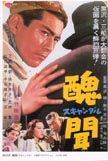 |
Scandal (1950)
A rising painter becomes entangled in
scandal after a chance encounter with a famed singer in the
mountains is discovered by a magazine reporter. This film
is a rebuke of the "right to know" argument the
media uses to rationalize their trampling of the private lives
of people.
|
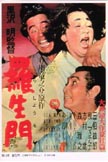 |
Rashomon (1950)
The novel, Yabu No Naka by Ryunosuke
Akutagawa, is creatively depicted on the screen in this Kurosawa
film. It focuses on the principle characters who narrate conflicting
versions of a single incident colored by their individual
perceptions and personalities. The film artfully examines
the virtues and vices of human beings.
|
| |
|
|
|
|
| |
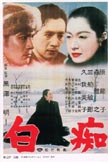 |
The Idiot (1951)
This is a film version of the novel, The
Idiot by Fyodor Dostoyevsky, and author highly regarded
by Kurosawa. His passion to remain faithful to the novel made
the film so long that he was requested by company officials
to shorten the film. Kurosawa responded with a now famous
remark telling the company to physically cut the film, not
the story, if they really desired it shortened.
|
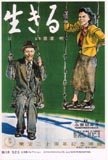 |
Ikiru (1952)
A civil servant working as Citizens Section
chief in a city office, having labored for thirty years without
purpose or satisfaction realizes he has been stricken with
cancer. He dedicates his remaining anguished days in construction
of a small park. Kurosawa gently emphasizes the meaning of
life through the soul of a man who is facing death.
|
| |
|
|
|
|
| |
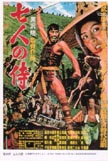 |
Seven Samurai (1954)
Out of his many distinguished releases,
this legendary masterpiece has not only moved countless audiences
but has also greatly influenced the film industry around the
world. Kurosawa's innovative technique of using multiple cameras
was first used in the making of this film. The film tells
the story of seven samurai summoned to protect a village and
its inhabitants from bandits. The strong personal traits of
each of the samurai are elaborately depicted, gripping the
attention of the audience.
|
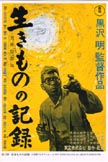 |
I Live in Fear (1955)
An aged owner of a factory, terrified
of nuclear radiation, comes up with a plan to sell all his
wealth and move to Brazil, involving his entire family. The
film depicts the ownder who is driven into a corner by the
discrepancy he senses with the people surrounding him, who
think the hydrogen bomb somewhat irrelevant to their lives.
The 35-year old Toshiro Mifune succeeds in portraying the
role of a 70-year old man with the artfully applied makeup
of Junjiro Yamada.
|
| |
|
|
|
|
| |
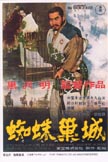 |
Throne of Blood (1957)
In this film based on Shakespeare's Macbeth,
Kurosawa incorporates Noh elements in the performance, making
the film his own expression. The magnificent set of Kumonosu
Castle, constructed on the second station slopes of Mt. Fuji,
is acknowledged as a landmark in the history of set design
and manifests Kurosawa's determination and creativity in stage
effects.
|
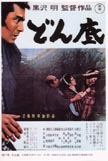 |
The Lower Depths (1957)
The play, The Lower Depths by Maxim
Gorky, is adapted by this Kurosawa film set in the Edo period.
Kurosawa enchantingly projects the precarious lives of destitute
people, who for differing personal reasons, drift to a shabby
wooden tenement house. The use of multiple cameras is also
displayed in this film.
|
| |
|
|
|
|
| |
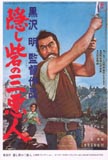 |
The Hidden Fortress (1958)
A period drama telling the story of a
samurai leader attempting to restore his master's household.
Breaking through enemy lines, he delivers the royal fortune
and young princess to allies with the help from two peasants.
It is widely acknowledged that this film was the primary inspiration
for George Lucas' Star Wars.
|
 |
The Bad Sleep Well (1960)
The film tells the tragic life of a man
who seeks revenge by wedding the daughter of the man who coerced
his father to commit suicide in order to cover up his company's
extortion. Having wanted to create a film with deep socail
significance, Kurosawa chose as his theme a contemporary social
issue which Japan was struggling with. This film was the first
film produced by Kurosawa Productions, Inc.
|
